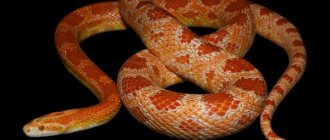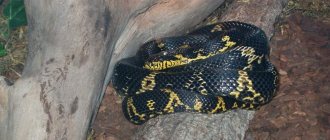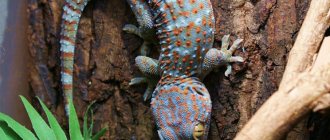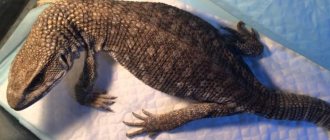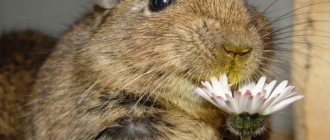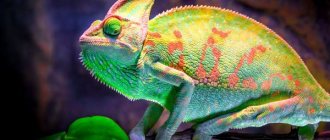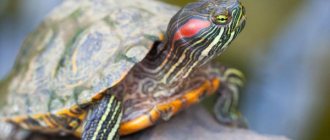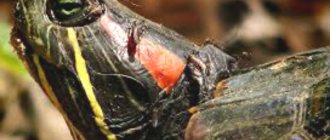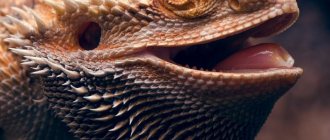The snake is probably one of the most popular snakes to keep at home. Our Panteric nursery breeds a wide variety of corn snakes. They differ in color variations and even the number of scales; in breeding there are completely bald individuals.
The snakes are not large, their size does not exceed 1.5-2 meters. They are slender, graceful snakes, have a friendly and calm disposition, are easy to care for and are ideal as a first snake for beginners.
The corn snake lives in America - from New Jersey to Florida and west to Texas. They can be found in forest clearings, crop fields, even in abandoned or rarely used buildings or farms. Snakes mainly live on the ground, but can climb trees and other heights.
Snakes are active at night or in the pre-dawn hours; during the day they prefer to hide in shelters.
Why corn snakes are good to keep indoors
Keeping a corn snake in an apartment does not cause much trouble.
These snakes are well tamed, recognize the owner, never attack people first, and are not poisonous. Even far from the homeland of rat snakes, exotic lovers are happy to purchase them for a lot of money as pets. The size of the snake is also convenient for keeping in an apartment - it only needs a small, compact terrarium, which is kept clean and at the required level of humidity. Behind the transparent glass, the bright colors and natural grace of the corn snake are pleasing to the eye. You can even play with them - they behave calmly in the hands of their owner.
Morphs
Morphs are color variations that appeared as a result of the work of geneticists. By influencing the gene responsible for pigmentation and color, scientists were able to obtain several color variations, which we will discuss later.
Important! Morphs are the same snakes in which only the color color has been changed, all other parameters and character remain the same.
- Oketee snake - distinguished by pronounced red spots, which are framed by a black border. The spots are rectangular or oval in shape with slightly smoothed or deformed corners.
- Did you know? The corn snake got its name because on farms it lived in corn fields, where it looked for prey.
Snake Miami - the spots are colored dark orange, and the main tone turns to gray or grayish-pink tones. - Emory Snake — the main tone is gray with a barely noticeable bluish tint. The spots are carrot-colored with slight darkening around the edges.
- Pink snake - characterized by the absence of black stripes. The spots also have a pinkish color, which is why the variation got its name. At the same time, the spots still stand out against the background of light scales, since they have a brick color with slight darkening.
There are also a considerable number of mutations. The most interesting “mutant”, which also has a color variation, is the Blizzard snake, which has a pure white scale color, only in very rare cases can a yellowish spot be detected.
Reptile lovers will be interested in reading about keeping leopard geckos, chameleons, red-eared turtles, iguanas and crocodile in the house.
Lifestyle of corn snake
Adults crawl well and can climb to fairly large heights, but young ones do not have enough strength for this. In winter, these reptiles hibernate and wake up only with the arrival of warm spring days. They begin to be active around mid-May, when the grass is already quite tall. In their natural habitat, they crawl into secluded places for the winter: under logs, into rock crevices, and the like.
They will also look for a secluded corner in the terrarium where no one will disturb the snake. The highest point of activity for snakes occurs at night or in the predawn, but during the day they prefer to rest. The reptile's favorite pastime is hunting rodents, lizards, and small birds. Having caught up with the target, the snake squeezes it tightly and strangles it.
Lifestyle
With proper care, the corn snake can live up to twenty years. A young corn snake lives only on the ground and does not have the strength to climb to higher ground. A mature snake is able to climb even very tall trees, although due to its lifestyle it does not require this.
In winter, the maize beauty hibernates and remains in a sleepy state until the onset of spring warmth; it begins to behave actively when the grass has already grown quite tall. In the wild, the snake crawls into rock crevices, under logs, or other secluded places for the winter. Sometimes in the middle of winter he can crawl out of his shelter for a short time to lie a little in the sun.
The main activity of a rat snake is hunting. It hunts small birds, rodents, lizards and invertebrates. Having caught up with the prey, she tightly squeezes it in her arms and strangles it.
The snake is active at night or before dawn; during the day, especially when it is very hot, it prefers to rest in the shade in a shelter, trying to choose a place where no one will disturb it.
Keeping at home
For the corn snake, horizontal terrariums measuring at least 50x40x40 cm are purchased. 1 individual or group of reptiles is released there - 1 male and 2 females. The reptiles' housing is heated using an electric rug. The temperature is controlled with a thermometer. Measure it at a distance of 3 cm from the substrate in a warm corner. At low temperatures, representatives of the species stop their digestion processes and their immunity decreases.
A cuvette with water is a required element . The reptile will swim in it and get wet during molting. Hidden places are made in the terrarium for the animal where it can rest. Objects collected from nature are placed in containers, having previously been treated with a chlorine solution. A ditch with peat moss is placed in a warm corner, and a dry shelter in a cold corner. It is recommended to use paper, coconut substrate or gravel. The terrarium should be sprayed daily with warm water.
Snake care includes:
- removal of fungus and dirt;
- replacement of bedding and liquid.
In summer, ultraviolet baths are organized. To do this, the reptiles’ housing is moved for the whole day to a place constantly illuminated by the sun, but do not forget that part of the container should remain in the shade.
Terrarium
A terrarium with good ventilation is required for maintenance (an aquarium will not work!!!). It's not cheap. If you don’t know how to glue yourself, then I offer a wildly convenient and budget option.
This is a regular toy box. Plastic, transparent. I bought it for 264 rubles. It’s convenient that the lid closes with some kind of locks, i.e. the snake will not wash off on its own. And they are guilty of this by the way.
So, they brought home such a box with dimensions of approximately 40*40*40; these are the cages I now have for snakes (ideally the same cage - but 40*40*20). When they grow up, the terr will increase in size and become 70*40*40. Using a hot awl and a fork, I melted holes for ventilation. I have three rows in the lid and three rows along the bottom of one of the walls. At the bottom we put napkins, newspapers, disposable diapers, and ideally coconut mulch. Softwood sawdust is highly undesirable; many snakes get sick from it. True, you have the opportunity to strip the bark from old pine firewood that has been lying on the street for at least a year, then you grind this bark and get a substrate. I have regular napkins.
We put a drinking bowl with clean, settled water. The drinking bowl is large enough for a snake to climb into, but not deep. We take any small box. I have one from under the light bulb and cut a hole - this is a shelter. This is where your corn will spend 90% of its time. Well, our terrarium is almost ready.
Temperature
Before planting the purchased snake there, we equalize the temperature. In a warm corner - +30C, background +25C. How to heat it up: a regular 60-watt light bulb with a mirrored back side. You can heat it completely through the wall of the cage - just make sure that the lamp does not melt it. We make sure to change the day-night regime. The night temperature should be approximately +23C. It can drop to +20 - in principle, this is not fatal.
Humidity
Humidity should be at least 60% while the kite is molting at least 70-80%%. How to maintain it is to spray the terrarium with water once or twice a day. We measure it with a hygrometer, but since they often lie and fail to work, it is quite enough to remember to spray the terra with water once a day. If your snake is happy and comfortable, it will sit in its hiding box and you will rarely see it enough.
And finally the most important thing.
Is it possible to keep several corn snakes in one terrarium?
Of course, it is possible, and even necessary, if the size of your terrarium allows it! A maximum of two females are allowed per male in the terrarium. Attention! When snakes come out of hibernation, they need to be temporarily planted. And you will also have to feed everyone separately .
Feed
Snakes do not eat meat, chicken, vegetables, fruits! There are snakes that can eat other snakes and lizards, there are those that love fish and frogs, and there are even those that eat snails. The corn snake eats mice and rats! ONLY MICE AND RATS!!!
Before buying a snake, take care of the food for it. There are two options: either you breed mice yourself, or buy them. Since you will most likely get a “lace” 18-20 centimeters long, you need to feed it naked. Those. newborn mice. It’s more convenient to either buy them alive and freeze them, or buy them already frozen. Store in the refrigerator for up to six months. I take 10-20 pieces at a time from a keeper I know. Already frozen. Another point - the size of the food should be no thicker than the snake’s head. It is important! If the food is frozen, then defrost it in warm water. The mouse must be warm. Apply using regular tweezers. You can put a mouse in front of the snake's face - it will see it, you can move the mouse with tweezers. As soon as the snake grabs the food, we leave it alone.
We also place live pebbles in the terra closer to the snake. The size of the food increases as the snake grows. At 8 months you can already give out “runners”, at six months they will be pubescent. But again, base it on the size of the snake’s head.
After you have bought the snake and brought it home, give it rest. He's scared. Let him get used to it. Do not touch it at all for 3-5 days. However, do not forget to change the water in the drinking bowl every day! Don’t be alarmed—maizes love to rattle their tails out of fear. This is fine. Maizes do not sizzle in principle. Although they can exhale through their nose - if you listen, it sounds like a hiss. Maize has nothing to actually bite you with. But no one has canceled food instincts. A hungry snake may confuse your fingers with mice, especially if they smell like mice. Although mine also smell chicken)))
Check with the seller when he fed the snake. They feed the snake once every 4-5 days with one naked thing. But there is a point - the snake is fed after it has spoiled itself (yes, that’s exactly what they say) a couple of days later. During molting, DO NOT FEED the snake!!!
After feeding,
do not touch
the snake. This can cause burping, which is bad. Also, the snake does not have a feeling of satiety. Therefore, do not overfeed. I give a maximum of two pebbles once a month, and one mouse at a time.
What to feed
An approximate feeding schedule for a corn snake looks like this:
0-7 months - naked mice (newborn one-day old mouse) 1 pc. once every 4-7 days 8 - 12 months - mice are furred, 1 pc. once every 7 days 1-1.5 years - runner mice or small rats, 1-2 pcs. once every 7 days 1.5-2 years - 1-2 large mice, 1 adult mastomys, 1-2 chickens or 1 small rat, 2-3 times a month
Until the age of 1.5 years, maizes can be fed frequently; their growing body and metabolism allow this; after 1.5 years, it is better to feed the animals once every 2-3 weeks. However, some individuals may continue to beg.
IMPORTANT: do not feed them. It is better to underfeed a reptile a little rather than overfeed it; in nature, they cannot always find as many KOs as you can offer them according to your schedule.
Vitamins
It should be noted that a healthy corn snake, in principle, does not require vitamins, because they feed on rodents, which in themselves are highly nutritious and vitamin-rich food. Some females can be given calcium supplements to help restore the body after laying eggs during the breeding season. In some cases, some medications may be prescribed by a herpentologist.
Food for corn snake
Laboratory mice are perhaps the most common food for snakes that can now be bought in many pet stores. Also, they are often bred at home.
Approximate size of feed mice (without tail):
2.5 - 3 cm velvet mice:
3.5 - 4.5 cm hairy mice:
4.5 - 5 cm runner mice:
6 - 8 cm large mice:
8 - 10 cm large mice:
Rats - known to everyone for a long time and found in almost any zoo and on Avito in large quantities, are larger rodents, it is more convenient to give them when the snake has already grown up, for example, 1 rat pebble can be a good replacement for 2-3 mouse pebbles. But mostly mice are found on sale. They often breed at home.
Mastomys is an African multi-mated mouse, found as food mainly among those who breed them themselves, and can also often be found for sale via the Internet. This species has become most attractive to terrarium keepers because of its fertility. Namely: a female Mastomys brings from 6 to 18 mice per litter (laboratory mice usually have a maximum of 8-10 mice). But for this you need to comply with certain conditions.
Also, Mastomys practically do not suffer from cannibalism: if you keep them in a group (for example, 2 males / 3-5 females), they do not carry mice from each other, but put them in 1 nest and feed them all together, even the males take care of the babies, and warm them when the females are resting or eating.
Usually there are 2 colors: agouti - ordinary gray with white, and agent - red with red eyes, according to my observations, the fertility of agents is a little better than that of agouti, maybe it’s just me, but I read that some people who keep them have - of course.
They love to chew, so it is better not to keep them in cages where there are protruding plastic parts, because. they will chew them through. To make their teeth itch less, you need to give rodents branches of sweet fruit trees, cuttlefish shell (not dyed) and dog food that does not have many additives (if it is very smelly, they most likely will not eat it), bran, and corn.
Regarding corn, I want to say that by regularly adding this additive to the food of your rodents, you can significantly increase the number of offspring even in ordinary mice - this is an old agricultural technique that was used back in the days of collective farms by feeding livestock with it. The method has been tested by me personally.
I will write in detail about Mastomis in a separate article, as soon as I can free up time for this.
Breeding
Breeding corn snakes at home is quite possible. Sexual maturity in reptiles of this species occurs at the age of 2-3 years. Females mature a little later than males. Corn snakes are classified as oviparous snakes. Copulation is short-lived, lasting 10-20 minutes. After mating, after one to two months, the females lay eggs. You need to make sure in advance that there is a ditch with sphagnum next to it at this time. It is there that she will lay a clutch of 6-35 eggs. This is where the participation of the snake in the production of offspring ends. The eggs must be placed in an incubator where the temperature is maintained at 27-29 degrees. The incubation period is 50-75 days, after which small corn snakes hatch from the eggs, their length is approximately 200-240 mm. The babies will start feeding after the first molt.
Corn Snake Substrate
These snakes love to burrow and hide, so using a layer of loose substrate (floor lining) at the bottom of the enclosure is key. A variety of materials can be used as the bottom layer of the housing. Inkless newspaper is a utilitarian choice as it is very easy to put away, but its appearance in the cage leaves much to be desired. You can use indoor/outdoor carpeting, and if you cut two pieces, you can rotate them, replacing the clean one with the dirty one while cleaning; Before use, wash and dry the contaminated product thoroughly.
For the top layer you can use aspen shavings. Wood shavings stained with feces can simply be scooped up; If necessary, clean and refresh the chips. Move the snake to a separate feeding container to prevent accidental ingestion of shavings. Do not use pine or cedar shavings because the aromatic oils may cause irritation and breathing problems for your pet reptile.
Sand, soil, and corn cobs are also unsuitable substrates for corn snakes.
Advantages and disadvantages
Before you decide to purchase a corn snake as a pet, you need to carefully weigh the pros and cons. To do this, let's look at the disadvantages and advantages of this beautiful reptile. Advantages: • Propagates well at home. • Easily adapts to the conditions in which it is kept. • Corn snake morphs are very interesting and vary in color. • Due to its relatively small size (1.5 m), it does not require special maintenance or overly large terrariums. Disadvantages: • They like to explore a new area and are able to run away, so in order to avoid such a nuisance, it is necessary to take timely measures to arrange their housing. • It is often affected by bacteria, so it is necessary to closely monitor the health of the snake and maintain cleanliness in the snake’s “house”. Based on the above, we can conclude that the corn snake will not cause much trouble to its owner, but will add plenty of positive emotions.
Temperature range for corn snake
Maintaining the correct temperature in your corn snake's home is vital. An overhead incandescent light is the preferred heating method, but corn snakes come from temperate climates, so they don't need tropical temperatures. Maintain the ambient temperature between 26.7 and 29 C. The bathing area should be between 29 and 31 C. At night the temperature should only drop to 24 C. Heating pads or heat tape can be used under the tank, but they may make it difficult to monitor how The case gets hot, so use thermometers inside.
Corn snake and man
The corn snake, the price of which is not too high (from 2.5 thousand rubles and above depending on a number of factors), will be a wonderful pet. It is considered the best snake for beginners in reptile breeding and is ideal for the first inhabitant of a home terrarium. This opinion is explained by the fact that this handsome man has a peaceful character and is completely unpretentious in his maintenance. It is better to purchase a cub, it will be easier to tame. The corn snake lives calmly next to humans, showing absolutely no fear. He quickly begins to recognize his owner, gets used to his hands and loves to accompany him in household chores. It is simply impossible not to love this beautiful creation of nature!
Precautionary measures
This snake is not poisonous. Corn snakes secrete poison, but it is only dangerous to cold-blooded animals. The reptile only shows aggression when it is hurt. Therefore, many people like to keep a snake at home, because it is not dangerous even for a cat. It is forbidden to pick up the snake after feeding. The reptile may vomit what it eats.
CAPE MONITOR: MAINTENANCE AND CARE AT HOME, PHOTO
LEOPARD EUBLEPHAR: CARE AND MAINTENANCE AT HOME
COMMON FROOM: CONTENT IN A TERRARIUM, FEEDING, PHOTO, VIDEO.
Diseases
The diseases you may encounter in snakes are usually caused by improper handling and poor living conditions.
- Regurgitation of food: a very common phenomenon in snakes, which occurs if the snake is disturbed immediately after eating. Or not warming up the snake properly. After regurgitation, you do NOT need to feed the snake again, you need to wait about 10 days, or better yet longer, and only then repeat the meal.
- Calcium deficiency. Snakes do not need to be given additional mineral supplements; they receive all the necessary nutrients by eating the whole food item. Rodent bones are the main source of calcium for snakes. If the snake is fed with inappropriate food, deformation of the limbs may occur.
- Bad shedding. Any healthy snake sheds entirely, also called “stocking.” It is very easy to determine when molting has begun - the color and even the eyes of the snake become cloudy, this is a sign that you need to additionally moisten the substrate in the terrarium and take a break from feeding. If the snake sheds in pieces, you need to help it and remove the remaining skin, after holding the snake in a bath of warm water.
